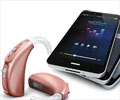An electrically conductive membrane implanted inside a model ear simulates cochlear hairs by converting sound waves into electrical pulses and the wiring connects the prototype to a device that collects the output current signal.

‘A new flexible device can treat hearing loss without batteries based on the Piezo-Triboelectric effect.’





When the hair cells inside the inner ear stop working, there’s no way to reverse the damage. Currently, treatment is limited to hearing aids or cochlear implants. But these devices require external power sources and can have difficulty amplifying speech correctly.One possible solution is to simulate healthy cochlear hairs, converting noise into the electrical signals processed by the brain as recognizable sounds.
To accomplish this, previous researchers have tried self-powered piezoelectric materials, which become charged when they’re compressed by the pressure that accompanies sound waves, and triboelectric materials, which produce friction and static electricity when moved by these waves.
However, the devices are not easy to make and don’t produce enough signal across the frequencies involved in human speech.
So, they wanted a simple way to fabricate a material that used both compression and friction for an acoustic sensing device with high efficiency and sensitivity across a broad range of audio frequencies.
Advertisement
This step left behind a sponge-like membrane with spaces around the nanoparticles, allowing them to jostle around when hit by sound waves.
When they sandwiched the membrane between two thin metal grids, the acoustic sensing device produced a maximum electrical signal at 170 hertz, a frequency within the range of most adults’ voices.
Finally, the researchers implanted the device inside a model ear and played a music file. They recorded the electrical output and converted it into a new audio file, which displayed a strong similarity to the original version.
This can be a self-powered device that is sensitive to the wide acoustic range needed to hear most sounds and voices.
Source-Medindia















